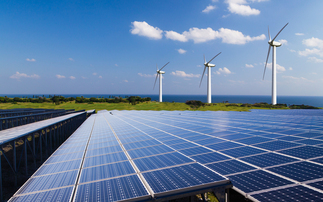How will be businesses be impacted by the pledge to 'ensure sustainable consumption and production patterns'
Targets
12.1 Implement the 10-year framework of programmes on sustainable consumption and production, all countries taking action, with developed countries taking the lead, taking into account the development and capabilities of developing countries.
12.1.1 Number of countries with sustainable consumption and production (SCP) national action plans or SCP mainstreamed as a priority or a target into national policies.
12.2 By 2030, achieve the sustainable management and efficient use of natural resources.
12.2.1 Material footprint, material footprint per capita, and material footprint per GDP.
12.2.2 Domestic material consumption, domestic material consumption per capita, and domestic material consumption per GDP.
12.3 By 2030, halve per capita global food waste at the retail and consumer levels and reduce food losses along production and supply chains, including post-harvest losses.
12.3.1 Global food loss index.
12.4 By 2020, achieve the environmentally sound management of chemicals and all wastes throughout their life cycle, in accordance with agreed international frameworks, and significantly reduce their release to air, water and soil in order to minimize their adverse impacts on human health and the environment.
12.4.1 Number of parties to international multilateral environmental agreements on hazardous waste, and other chemicals that meet their commitments and obligations in transmitting information as required by each relevant agreement.
12.4.2 Hazardous waste generated per capita and proportion of hazardous waste treated, by type of treatment.
12.5 By 2030, substantially reduce waste generation through prevention, reduction, recycling and reuse.
12.5.1 National recycling rate, tons of material recycled.
12.6 Encourage companies, especially large and transnational companies, to adopt sustainable practices and to integrate sustainability information into their reporting cycle.
12.6.1 Number of companies publishing sustainability reports.
12.7 Promote public procurement practices that are sustainable, in accordance with national policies and priorities.
12.7.1 Number of countries implementing sustainable public procurement policies and action plans.
12.8 By 2030, ensure that people everywhere have the relevant information and awareness for sustainable development and lifestyles in harmony with nature.
12.8.1 Extent to which (i) global citizenship education and (ii) education for sustainable development (including climate change education) are mainstreamed in (a) national education policies; (b) curricula; (c) teacher education; and (d) student assessment.
12.A Support developing countries to strengthen their scientific and technological capacity to move towards more sustainable patterns of consumption and production.
12.A.1 Amount of support to developing countries on research and development for sustainable consumption and production and environmentally sound technologies.
12.B Develop and implement tools to monitor sustainable development impacts for sustainable tourism that creates jobs and promotes local culture and products.
12.B.1 Number of sustainable tourism strategies or policies and implemented action plans with agreed monitoring and evaluation tools.
12.C Rationalize inefficient fossil-fuel subsidies that encourage wasteful consumption by removing market distortions, in accordance with national circumstances, including by restructuring taxation and phasing out those harmful subsidies, where they exist, to reflect their environmental impacts, taking fully into account the specific needs and conditions of developing countries and minimizing the possible adverse impacts on their development in a manner that protects the poor and the affected communities.
12.C.1 Amount of fossil-fuel subsidies per unit of GDP (production and consumption) and as a proportion of total national expenditure on fossil fuels.
Progress to date
The breadth and ambition of SDG12, coupled with the relatively immature nature of some of the metrics used to assess levels of sustainable consumption and production, makes analysing progress more difficult than is the case for most of the SDGs.
However, what metrics are available point to a worrying picture. The UN's most recent progress report starts with the blunt assessment: "Decoupling economic growth from resource use has been challenging."
The report cites overarching figures for domestic material consumption (DMC) which gives an indication of materials used in production processes within an economy. Globally DMC per unit of GDP rose from 1.29kg to 1.41kg per dollar of GDP between 2000 and 2015, indicating more materials are required to produce a unit of output than was the case at the turn of the century. Total DMC also rose between 2000 and 2010, climbing from 48.7 billion tons to 71.0 billion tons, driven in large part by the rapid expansion of manufacturing-reliant emerging economies. The UN warned these trends will have "consequences in terms of both resource pressures and associated environmental impacts".
National governments are taking steps to tackle air, water and soil pollution, enhance resource efficiency, reduce food waste, boost recycling rates, and encourage corporate sustainability reporting. But progress remains extremely varied and even in some countries where recycling infrastructure is well established, such as the UK, efforts to improve recycling rates and reduce food waste have stalled in recent years.
Moreover, many countries are yet to enact any effective production and consumption policies. The UN progress report reveals that as of 2018 71 countries and the EU have formally reported on macro-policies, regulatory, voluntary or economic instruments that support the shift towards sustainable consumption and production patterns. In total 109 countries are thought to have or had national policies and initiatives relevant to sustainable consumption and production. But that still leaves just under half the world's nations with no such policies.
Further evidence of the patchwork nature of global efforts to encourage more sustainable consumption and production are found in the levels of compliance with international environmental agreements.
The Paris Agreement may have been backed by every country (even if the US is now planning to quit the accord) and the Montreal Protocol covering ozone damaging gases has a 100 per cent compliance rate. But the Rotterdam Convention covering the use of hazardous chemicals and pesticides only has a 71 per cent compliance rate, despite being enacted in 2004. Again, the US has refused to ratify the agreement.
Backing for the Basel Convention on the movement of hazardous waste and the Stockholm Convention on Persistent Organic Pollutants is worse still, with 57 per cent and 51 per cent compliance, respectively.
Relatively few governments have moved beyond lip service towards sustainable consumption and production and many are yet to engage with the issue at all at any meaningful level.
"Achieving Goal 12 requires a strong national framework for sustainable consumption and production that is integrated into national and sectoral plans, sustainable business practices and consumer behaviour, together with adherence to international norms on the management of hazardous chemicals and wastes," the UN states. The problem is even those countries and businesses with the most advanced environmental governance systems and strategies are struggling to develop truly sustainable consumption and production patterns.
Business implications
The potential implications for businesses of SDG12 are both enormous in their scale and reach, and extremely difficult to track.
Take the overarching goal and its pledge to "ensure sustainable consumption and production patterns". That implies an end to unsustainable consumption and production patterns. Followed through to its logical extreme, that's a huge commitment. It suggests policies to actively pursue an end to the consumption of a whole raft of products and industries that are to all intents and purposes unsustainable in their current form, alongside the radical reform of unsustainable production techniques that have dominated some sectors for centuries. It raises huge questions about the very nature of consumer-led economies and the long term viability of profits generated from endlessly increased consumption.
It is easy to dismiss the possibility of sustainable consumption policies. After all, progress to date against SDG12 has been limited and there are few, if any, governments that have secured and retained power on a platform of 'consume less'.
But at the same time it would be wrong to reject the possibility out of hand. Savvy businesses are already responding to the trend towards dematerialised products, services, and experiences, beloved of millennial consumers. Meanwhile, the global push to slash the use of plastic straws and curb the market for disposable coffee cups has shown how once it gains traction interest in sustainable consumption can destroy entire markets. Speculation continues to mount over whether or not some martkets have reached 'peak car', as car-sharing and other transport services become mainstream.
At the same time, sustainable production patterns are on the agenda of many governments and businesses, as a growing number of leaders recognise how the need to cut greenhouse gas emissions and enhance resource security necessitates more circular material flows and efficient production practices. If governments really do implement ambitious 10 year frameworks for delivering sustainable consumption and production then businesses are likely to be impacted at all levels. The achievement of "sustainable management and efficient use of natural resources" implies a genuine revolution in resource use and business models globally.
More specifically, SDG12 may at times feel like a holding pen for a raft of targets that could not be fitted in under the other goals, but many of those targets have still have huge direct business implications.
For example, the target to halve per capita global food waste at retail and consumer levels by 2030 is bracingly specific and suggests much more ambitious food waste policies will have to be enacted that will affect the entire global food industry.
Similarly, the pledge to renew efforts to bring more countries under the auspices of hazardous chemicals conventions and "substantially" reduce waste levels and boost recycling rates implies significantly more ambitious waste policies will be introduced in the coming years.
More broadly the promise to encourage more companies to report on their sustainability performance will provide yet more momentum behind the calls for more mandatory reporting rules, while the pledge to boost education around sustainability issues should further increase public interest in corporate responsibility. Promoting more sustainable public procurement practices should create major new markets for green businesses.
Finally, the target to rationalise inefficient fossil fuel subsidies may be a sub-target and may echo largely ignored G20 promises to phase out fossil fuel subsidies, but if enacted such a move would represent one of the simplest and most effective measures for curtailing pollution and boosting clean energy investment.
Business risks
The business risks associated with SDG12 are considerable. The continuation of unsustainable consumption and production patterns is, by definition, unsustainable. Inefficient resource flows will make meeting other SDGs covering poverty eradication and climate change, to give just two examples, much harder if not impossible to meet. At the same time investors and business leaders are already concerned about resource insecurity, commodity price volatility, and various industries that could be approaching environmental limits. A failure to accelerate the development of more sustainable consumption and production models will only amplify these concerns.
On the flip side, enacting sustainable consumption and production policies will create losers and winners, with some industries potentially facing an existential crisis. Large parts of industries such as 'fast fashion', plastics and packaging, consumer technology, food, and chemicals are yet to wrestle with products and business models that are based on linear resource flows and arguably damaging levels of highly inefficient consumption.
Some countries are beginning to consider bolder action in these areas, with material taxes, re-use and recycling incentive schemes, and outright bans on certain products all firmly under discussion. Businesses that fail to adapt to this reality will face major pressure on revenues, as well as continued reputational risks.
Chemicals regulations will inevitably tighten over the coming decade, along with public acceptance of products that are perceived to be environmentally damaging - a trend that could lead to major disruption to global supply chains.
A concerted global effort to promote better corporate sustainability strategies and more standardised reporting will create new regulatory and reputational risks, as well as increased pressure, for those businesses that are yet to develop credible sustainability strategies. The trend is also likely to start to extend down the business supply chain to take in small and medium sized enterprises.
Any phase out of fossil fuel subsidies would introduce significant risks for the energy and transport sectors, especially as the cost of clean tech alternatives continues to fall.
Business opportunities
As the UN's progress report makes clear, the shift towards more sustainable consumption and production patterns remains at a fledgling stage. However, there are businesses and governments that are starting to engage with the concept and recognise the commercial and economic opportunities it can offer.
For example, a growing number of progressive businesses, especially in the retail and technology space, are pioneering new service-based or circular economy-style products, extending product life, encouraging re-use, and ensuring recycling occurs. From car sharing and leasing models to repairable and upgradable gadgets or clothes that are designed for years, not months, some businesses are opening up new revenue streams through more sustainable consumption models.
At the same time, many businesses are starting to recognise that higher levels of resource efficiency may require investment in improved design and better materials, but they can also deliver lower costs and improved resource security in the long run. Again, whole new industries are opening up for businesses that can deliver more efficient and durable materials or ensure materials are reused at the end of their original life.
Similarly, efforts to tackle food waste promise massive cost and greenhouse gas emissions savings and as such a new international business-led coalition has already been launched to advance best practices around the world under the banner Champions 12.3.
Similarly, the pledge to advance sustainable tourism strategies can only benefit an industry that is set to face significant environmental and policy challenges in the coming decades.
More generally, research has repeatedly shown that the adoption of effective corporate sustainability strategies and reporting can often lead to improved financial performance, reputational gains, better productivity, and lower risk profiles for investors. For those businesses already embracing such strategies the creation of a more level playing field where rivals are also required to disclose their sustainability performance can only help both them and their investors.
More public awareness amongst citizens of sustainable development and "lifestyles in harmony with nature" can only help drive the growth of green business and clean tech markets. Meanwhile, improved chemicals and hazardous waste regulations will serve to reduce environmental risks for all businesses. Any rebalancing of global energy markets caused by the removal of fossil fuel subsidies would boost clean energy markets and mobilise increased investment in energy efficiency.
In summary, sustainable consumption and production patterns can create massive new opportunities for businesses, but many of them will have to embrace new technologies and fundamentally change their business models to exploit them.










